
 |
| DICK NORBERG / NORBERG DESIGN (DETAIL) |
| Claes Brodersson Rålamb was born into minor Swedish nobility on May 8, 1622. His father was, for a time, governor of Finland. Rålamb returned from Turkey in 1658, held a number of important offices and was made a baron in 1674. (This portrait shows him in baronial robes.) That same year, he founded Stockholm’s Auktionsverk, now the oldest auction house in the world still operating. By 1680, however, he had fallen out of favor with Charles xi, whom he had helped raise, and lost much of his wealth to fines imposed by the king. He retired to his estates, which numbered at least five, and at the time of his death in 1698, he was one of the most respected men in Sweden. |
 n fact, the growing empire was Sweden; its king, Charles x Gustav, age 35; the nobleman, Claes Brodersson Rålamb, just six months his monarch's elder. The more powerful empire was the Ottoman Empire, with Istanbul its capital. Between the empires lay
realms each sought to control and influence—principally Poland, Transylvania and Austria-Hungary. The year was 1657.
n fact, the growing empire was Sweden; its king, Charles x Gustav, age 35; the nobleman, Claes Brodersson Rålamb, just six months his monarch's elder. The more powerful empire was the Ottoman Empire, with Istanbul its capital. Between the empires lay
realms each sought to control and influence—principally Poland, Transylvania and Austria-Hungary. The year was 1657.
At the start of the 1600’s, Sweden was a regional power in the Baltic, and by mid-century it had become a major power in Europe. Controlling most Baltic trade in iron, copper, timber, tar and furs, the Swedish Empire included modern Sweden and parts of today’s Norway, Finland, Latvia, Estonia, Denmark and Germany. Sweden had battled Denmark, Poland and Russia at different times during the first half of the century, winning much economic control. Its alliance with France during the Thirty Years’ War brought it other strategic gains against Denmark and German states. The region’s only other important state—thanks to its control of the Baltic Sea’s south coast—was the Polish-Lithuanian Commonwealth.
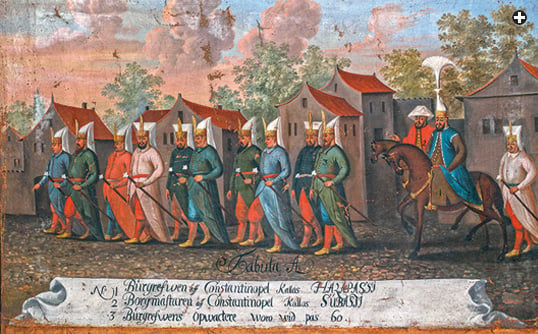
|
| On September 24, 1657, Swedish ambassador Claes Rålamb watched the procession of the court of Sultan Mehmed iv as it passed through the streets of Istanbul on its way to Edirne, most likely for roya hunting. He took detailed notes of the event, and he later commissioned a series of 20 paintings depicting the procession. Each painting is also labeled, in Swedish, to identify the functions of the participants, who numbered far more than actually appear on the canvases. The first painting shows the governor and mayor, with their attendants. |
In 1655, disgruntled Polish-Lithuanian nobles with ties to Sweden invited Charles x to invade. Charles did, but it did not go well. By the next year, Sweden found its resources overstretched, and its only ally, Brandenburg-Prussia’s ruler Frederick iii, began to waver. Sweden urgently needed another ally. Its territorial gains in Poland and, indeed, its position as a European power, were at stake. Adjoining German states were not interested, and relations with Russia and Denmark were poor. That left only Transylvania, an Ottoman vassal state ruled by a prince whose ambition was already causing consternation in Istanbul.
Sweden and Transylvania had, at different times and for different reasons, fought some of the same states, and both had joined Turkey as indirect allies during the Thirty Years’ War. In King Charles’s opinion, this was enough to justify agreeing to an alliance. In exchange for Transylvania’s military aid, Charles promised Transylvania’s leader, Prince George Rákóczi ii, unspecified Polish territory, as well as the right to claim the Polish monarchy. Much of Transylvania was already Rákóczi’s personal property, and the addition of parts of southern Poland, along with the crown, would have significantly increased his power.
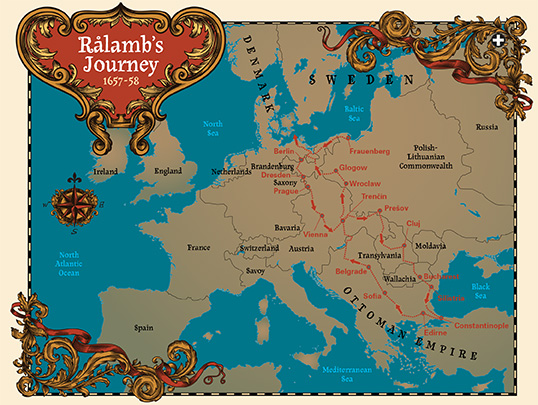 |
| AFTER JOHAN CALLMER’S 1962 MAP |
 t this time, Turkey was in a period of great instability. For years it had been battling the Venetian Republic; recently it had been losing. Peace with Persia in the east and Austria-Hungary in the west was fragile. Conflict with Russia was always a possibility. Factions in the Ottoman government fought for control of the state, and rebellions in Anatolia destabilized the empire’s heartland. A stronger Transylvania along Turkey’s northern border, ruled by an independent-minded monarch, would not be a good thing for the Ottomans.
t this time, Turkey was in a period of great instability. For years it had been battling the Venetian Republic; recently it had been losing. Peace with Persia in the east and Austria-Hungary in the west was fragile. Conflict with Russia was always a possibility. Factions in the Ottoman government fought for control of the state, and rebellions in Anatolia destabilized the empire’s heartland. A stronger Transylvania along Turkey’s northern border, ruled by an independent-minded monarch, would not be a good thing for the Ottomans.
In Istanbul, Grand Vizier Köprülü Mehmed Pasha took office in 1656, effectively replacing as regent the mother of the empire’s nominal head, Sultan Mehmed iv, who was 15 years old at the time. As regents, neither his mother nor his grandmother had been successful, and they ha been blamed for weakening Ottoman control over the empire. In accepting the appointment as grand vizier, Köprülü hoped to bring about stability and lead the country.

|
| Third in the series appear these ranks of azamoglani, “from among whom the Janissaries are taken,” led by a staff sergeant. Though Janissaries were professional soldiers—paid and free to marry—they were also slaves, bound for life to the sultan’s service. Rålamb remarked that, though the parade lasted hours, few spectators came out to watch until the sultan passed by, near the end. |
It was onto this political chessboard that King Charles x inserted Claes Rålamb (pronounced “row-lahm”), a man well prepared for his role as ambassador. After graduation from Sweden’s Uppsala University, he’d studied at Leiden University in the Netherlands, honing his language skills, traveling and learning European politics. In 1645, in his early 20’s, he participated in negotiations that ended Denmark’s involvement in the Thirty Years’ War. In his later 20’s and early 30’s he concentrated on his estates, started a family and wrote the first draft of a lifelong work on law. When Charles x was crowned Sweden’s king in 1654, he recruited Rålamb to service, and by May 1656 Rålamb was acting as civil governor of the Polish city of Posen (today’s Poznań). It was then Charles summoned him to his headquarters in Frauenburg, Prussia, and there Rålamb learned of his mission to Turkey.
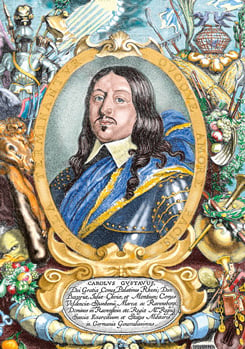 |
 |
| TOP AND ABOVE: BRIDGEMAN ART LIBRARY |
| Top: Crowned in 1654, Charles x gustav moved quickly to expand Swedish power in a drive to control the lands around the Baltic Sea. Above: Mehmed iv became sultan of the Ottoman empire in 1648 at the age of six, and he turned 17 during Ralamb’s visit to Istanbul. He remained on the throne for another 30 years, until 1687. |
Rålamb was to persuade the grand vizier, and thus the Ottoman sultan, to approve an alliance between Sweden and Transylvania. The two countries had in fact already allied earlier in 1656, but Transylvania’s contemplated invasion of Poland had to be approved by the Turks to be legitimate. Rålamb was also to ask that Turkey’s Cossack and Tatar vassals stop fighting in support of the Polish king. Sten Westerberg, whose biography of Rålamb was published late last year, commented that “in return Rålamb was authorized to offer absolutely nothing.” Worse, Rålamb was ordered not to seek a direct alliance between Sweden and Turkey. “He was, in effect, given impossible instructions,” Westerberg observed.
So, was there more going on? Charles’ offer of the Polish throne to Rákóczi seems contradictory, for the Polish nobles had invited Charles to the throne because he belonged to a branch of the family that already ruled Poland. Perhaps Charles used Rákóczi’s ambition to get desperately needed reinforcements, thinking that he could later rescind the promise without serious consequences.
In Istanbul, ambassadors from all the major European and Asian countries watched the Rålamb mission, news of which had leaked out, to see if these two powerful countries, each with growing vulnerabilities, would seek strength through collaboration.
The conquest of Poland-Lithuania aside, even an indirect alliance between Sweden and Turkey could strengthen the position of each in its region and as European powers. It could also potentially clear the way to a later direct alliance that could prevent conflict if the two ever came to share a border, for the Ottoman Empire had been slowly advancing into Eastern Europe.
In anticipation of Turkish approval of his actions, Rákóczi’s Transylvanian troops had entered Poland in December 1656. Although it is unlikely that Rákóczi was secretly encouraged by Sweden or Turkey to invade without explicit permission, Rákóczi in fact advanced Grand Vizier Köprülü’s interests by doing so: Deposing Rákóczi later for failure to get prior approval would give Köprülü the opportunity to install a more compliant ruler, should he wish to do so.
 e know much of this because Rålamb left a detailed record of his mission. An annotated copy of his personal diary, his report to King Charles x and other papers are now stored at the Kungliga Biblioteket, Sweden’s national library, and formerly secret diplomatic letters and documents are in the national archives outside Stockholm. Perhaps most interesting of all, there is a pictorial record: 20 large paintings that tell us something about Ottoman Turkey at the time. Commissioned by Rålamb and now at Stockholm’s Nordiska Museet (Nordic Museum), they depict a procession of the sultan’s court that took place on his reaching majority in 1657. Rålamb wrote about the procession, which likely took place in September, in his report to Charles: “He is then by their law obliged to repair to Adrianople [now Edirne], the ancient seat of the empire, and to undertake some expedition.” (For the figurehead sultan, that expedition was most likely the annual royal hunting expedition.)
e know much of this because Rålamb left a detailed record of his mission. An annotated copy of his personal diary, his report to King Charles x and other papers are now stored at the Kungliga Biblioteket, Sweden’s national library, and formerly secret diplomatic letters and documents are in the national archives outside Stockholm. Perhaps most interesting of all, there is a pictorial record: 20 large paintings that tell us something about Ottoman Turkey at the time. Commissioned by Rålamb and now at Stockholm’s Nordiska Museet (Nordic Museum), they depict a procession of the sultan’s court that took place on his reaching majority in 1657. Rålamb wrote about the procession, which likely took place in September, in his report to Charles: “He is then by their law obliged to repair to Adrianople [now Edirne], the ancient seat of the empire, and to undertake some expedition.” (For the figurehead sultan, that expedition was most likely the annual royal hunting expedition.)
Rålamb’s journey had begun some seven months earlier, on February 22, 1657. He opened his report to Charles by writing that he had been waiting in Stetin (Szczecin, in today’s Poland) for further instructions, as well as an answer to his request for a diplomatic passport that could assure safe passage through unfriendly German, Austrian and Hungarian territory. Rålamb ended his opening sentence with the words, “I was obliged to tarry at Stetin for these and other reasons best known to your majesty.” The diplomatic passport, however, was mysteriously delayed, likely because he planned to travel through countries that both Sweden and Turkey had fought against during the Thirty Years’ War; that Austria, Hungary and parts of Germany favored Poland against Sweden was also a factor.

|
| The fragmentary inscription translates “the learned are called ...” They followed, on other canvases, captains of the guard, footmen, generals, heralds, squires, 20 pairs of water carriers and more. The edges of this painting show both original canvas stretch marks and evidence of trimming. It is not known who painted the series, nor when, nor where. To art historians, the Rålamb series is both a unique depiction of the Ottoman court and a mystery: There are no signatures, no dates nor indications of where the paintings were produced. While the figures show stylistic affinity to Turkish and other Islamic miniatures, they are more individualized than is common for artists of that tradition; the townscape is entirely fanciful, unrelated to any known buildings of Istanbul and often appearing European. |
The rulers of Austria, Hungary and Germany did not know why Rålamb was being sent to Turkey, but they could guess that private communication between the two potential allies would not be in their interest. Prince Rákóczi had approached other countries besides Sweden about an alliance, so it was also possible that Austria, Hungary and Germany suspected that something was afoot that was directed against them and involved Transylvania. As a result, Rålamb went on to say, he would travel “incognito,” as word was already circulating that he was being sent to Turkey on a diplomatic mission, and that it would be in Sweden’s rivals’ interests for him not to arrive.
To throw off pursuit, Rålamb gave out word of conflicting departure dates and false route plans. His caution was evident when writing about approaching Dresden, Germany; he said, “Yet I would not venture to pass through that place, by reason of the strict inquiry made there,” and instead went around the city. Rålamb wrote that highwaymen and soldiers who “robbed the travelers in the country” were a hazard, and noted that “both sorts appear’d to us, but being four coaches together from Praag, and all well armed, they had not the courage to come near us.”
Nonetheless, Rålamb found that word of an ambassador from Sweden traveling in disguise had spread widely, and even going around Dresden did not throw off the chase. Constantly on guard, he was ready to change his route to avoid trouble. When passing through an area in modern Slovakia he took a particularly rugged mountain route that he described as “a passage so terrible to look upon, that it made my hair stand on end.” Later, in Polish territory, he encountered a postmaster “who was sly enough to ask questions, viz. whether we were envoys, or if the Swedish envoys that were expected would soon come.” The postmaster delayed them for hours, but Rålamb eventually persuaded him that he was a merchant. Further on, five cavalry-men started following them. When the travelers took refuge in a wayside inn, the cavalrymen stayed outside all night long, threatening to break in. Irate residents of the inn drove them off the next morning.
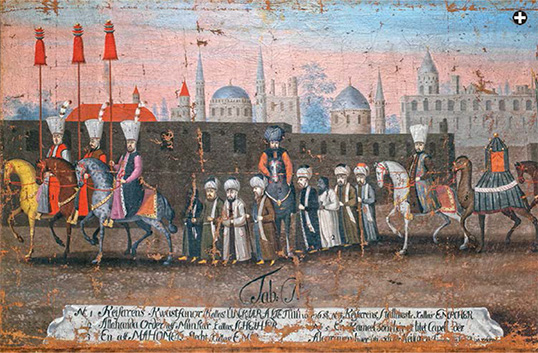
|
| Three riders (the inscription says there were actually six; Rålamb’s account says there were eight) carry the “unkiaraltetuiu”—the horse-tail standards of the sultan—followed by “monks of all kinds of orders,” the stablemaster and a camel bearing a “small chapel in which the Qur’an is placed,” used by the sultan for prayer during travel. In the background, the wall, domes and minarets were likely painte by an artist who had never actually seen them, whereas the costumes and descriptions of the parade are regarded as essentially accurate. |
On reaching Ottoman territory at Silistria, Rålamb immediately had to prove his diplomatic skills. The local governor, wrote Rålamb, was “at first pretty rough, but seeing that I returned proper answers to all his objections, he began to soften.” Rålamb understood how to read culture and psychology well enough to respond in a manner that established a more hospitable relationship. He wrote that the governor had commented to his staff: “‘No wonder we hear the Swedes so much talked of for soldiers, look upon this young man here, how boldly he speaks;’ afterwards he began to be good humour’d with me, and asked, why I did not let my beard grow?”
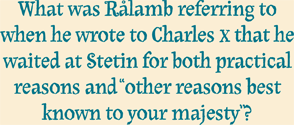 |
Rålamb reached Constantinople on May 14, 1657. His first audience with Grand Vizier Köprülü Mehmed Pasha took place three days later, and on May 19 he met Köprülü together with the sultan. By then, Rákóczi and his forces had been fighting in Poland for nearly four months, but the Ottomans knew that the Swedish and Transylvanian forces did not control the majority of Poland-Lithuania, and that both sides still had intact armies. And although Russia had declared war against Sweden in July 1656 and might have taken action, its plans were not clear. Thus Rålamb was unable to negotiate Ottoman approval of the Swedish-Transylvanian alliance during these two audiences.
Rålamb continued his lobbying on May 20, when protocol dictated that he next visit the mufti, or chief judge of Islamic law. The mufti, however, refused to see him, sending word that “he was but lately come into office” and that “he would inform himself of the affair, and afterward send me word.” Rålamb goes on to remark, “the main point was, he knew I was not come stocked with presents; and therefore the honor of receiving your majesty’s letter and compliment was of no account to him.” This and later contacts made it evident that, Rålamb’s lack of the customary diplomatic gifts aside, there were Ottoman officials who were simply not supportive of an alliance between Sweden and Turkey.
On May 21, Rålamb was informed he could have another audience with the vizier. They met the next day, in a more informal setting, with the vizier pointing out that Turkey had an existing alliance with Poland, and that “it would be wrong ... to abandon that old friendship for the new one with your majesty.” Rålamb recounts that “I thereupon remonstrated to him, that the friendship offered by your majesty was not new, but had begun in the time of king Gustavus, was continued by queen Christina.” The discussion went on until the vizier gave “a promise, that your majesty’s desires should be complied with in every respect,” and the vizier promised to immediately draw up documents. Rålamb believed that he was close to success.
 |
| Mounted on a white horse, preceded by footmen, the chief of the hunt and bowmen, Sultan Mehmed iv appears much older than his actual age: 17. Vizier Köprülü does not appear in the procession. |
Then, on May 27, the picture changed abruptly. Rålamb was informed by a messenger from the vizier that another Swedish embassy was expected, and that any Turkish decision would be postponed pending the arrival of that second embassy. Unbeknownst to Rålamb, King Charles had dispatched a second ambassador when he became concerned that Rålamb’s mission had been waylaid before reaching Turkey.
Rålamb became worried. The vizier was soon leaving to lead a military campaign against the Venetian Republic, and Rålamb knew that no action would be taken until he returned. That could be months. He asked for another audience, but received no reply.
At this point, Rålamb’s report departs from his story to describe, for more than 20 pages, the state of Ottoman Turkey and its history since 1634, when Sweden had last sent an ambassador. This narrative is interesting and insightful, and particularly notable for the absence of judgmental or derogatory comments, which show that Rålamb was able to think about another culture without seeing differences as flaws. Biographer Westerberg observed that what was “most striking was that he was open-minded.” Westerberg elaborated that Rålamb’s sense of humor, ingenuity and self-deprecating style added to his essentially positive outlook, and these traits made him even more open to new information. These qualities were critical assets, as Ottoman Turkey was a multi-cultural empire, with laws and customs that had evolved over time in their own context, and outsiders could—and often did—easily misinterpret the polyglot social world of the Ottoman capital.
 |
| After the sultan came eunuchs “who number 100,” some 200 falconers wearing their distinctive headgear, and the mehterhane or military band. This painting, too, appears to be trimmed—perhaps to fit with the rest of the series in a particular room. Ralamb never wrote about the paintings, which his descendants gave to Sweden’s nordic Museum (nordisk Museet) on permanent loan in 1937. |
Rålamb, however, concisely summarized what he learned about Islam, much of which came from Ali Ufki, a Pole who had embraced Islam and become a court musician. Rålamb’s use of neutral wording in his report thus helped his king learn about the Ottoman Empire and appreciate its religion. His lengthy summary of Turkey ended with the words, “Thus much may suffice for an account of the present state of Turky, and its relation to the neighbouring powers; I think it my duty next to resume my report of the negotiation I was entrusted with at that court.”
He then turned to describing his contacts and negotiations since the end of May. With the vizier away fighting the Venetians, the next highest official was the kaimakam, who over the following months was sometimes critical and sometimes supportive of Rålamb’s efforts. Then in early August came word that Prince Rákóczi and his forces had lost a major battle in Poland and were in retreat. The kaimakam ordered the Transylvanian ambassadors in Istanbul imprisoned, and for the next three weeks, Rålamb was unable to make contact with anyone in power. He feared the same fate as the Transylvanians—“indeed we expected no less at every moment.” I his report, he began to distance Sweden from Rákóczi with the observation that the prince had brought this reverse upon himself.
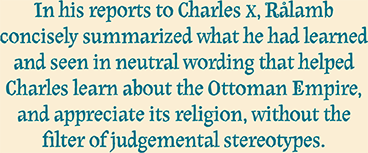 |
The next six months were a period of uncertainty. A new kaimakam was appointed. Rålamb remarked that this official’s goal was to “force money from us”—a bribe. When the vizier returned, Rålamb was eventually granted an audience, but by then it was February 20, 1658, almost exactly a year after he had set out. For the audience, he and his party traveled to Edirne after which they were expected to depart for Sweden. In the months since May 1657, much had happened: Rákóczi was no longer the undisputed ruler of Transylvania, and Turkish force had invaded that much-weakened country. On another front, a Swedish war with Denmark had begun in August 1657; that left Charles no longer interested in Poland, let alone alliance with Transylvania.
During the February 20 audience, the grand vizier stressed to Rålamb that Prince Rákóczi had failed to seek approval in advance, and that he had thus rebelled against Turkey. Rålamb countered by explaining that Sweden had been acting as Turkey’s friend by sending him to Istanbul to discuss the matter, and that Sweden had not encouraged Rákóczi’s insubordination. Although the Vizier orally agreed with Rålamb, he declined to rewrite his official letter to Charles rejecting cooperation between Turkey and Sweden. Nonetheless, he asked Rålamb to relay positive, if unwritten, assurances that could leave the door open for future cooperation.
The return trip was easy: A diplomatic passport, arranged by the Ottomans, made it possible for the party to enter Austria-Hungary-Germany uneventfully, and to travel openly as diplomats. Rålamb reached the Swedish port city of Gothenburg in late May 1658.
 |
| KARL-HENRIK STIERNSPETZ |
| At the center top of Rålamb’s coat of arms, between two helmets of armor, is an Ottoman turban with an aigrette. The prominence of the symbol hints at the significance of his mission. |
There, he met with King Charles at least twice. Westerberg wrote that Rålamb and the king conversed for four hours “in private concerning the Turkish journey and other matters.” Soon afterward, Rålamb took a role in a resumed campaign against Denmark, which he held until the king’s death a year and a half later in 1660. Crown Prince Charles xi was only five years old when he succeeded his father as king; over the years that followed Rålamb played an important role in his upbringing, and indeed in the governance of Sweden during the regency.
 as Claes Rålamb’s mission to Istanbul a success or a failure? If we look only at whether or not he successfully negotiated with Ottoman Turkey for a formal alliance between Sweden and Transylvania, it was an obvious failure. Despite his 15-month effort, Rålamb came back empty-handed.
as Claes Rålamb’s mission to Istanbul a success or a failure? If we look only at whether or not he successfully negotiated with Ottoman Turkey for a formal alliance between Sweden and Transylvania, it was an obvious failure. Despite his 15-month effort, Rålamb came back empty-handed.
If we look more closely, however, there are indications that his mission was such a success that he was rewarded with further assignments and the enduring confidence of the king. And then there are the paintings: Were they a commemoration of a mission whose goals were never fully written down?
In 2004 the Swedish Research Institute in Istanbul put together a joint Turkish-Swedish team to study the paintings. Institute director Karin Ådahl, who also edited publication of the team’s research in the 2006 book The Sultan’s Procession, noted that the paintings are unique for their time. “Iconographically nothing relates to Rålamb’s paintings in style, and no other diplomat in the period ordered anything of the kind,” she observed. That uniqueness indicates that their purpose was something more than to record a procession. “I believe he intended to present them to the King,” said Westerberg. But, he added, why would Rålamb present paintings—especially a monumental series of paintings—associated with a failure? And why would the king spend four hours meeting privately with an ambassador who had failed? Another tip-off that there may have been more going on is Rålamb’s cryptic comment, in the opening sentence of his report to Charles, regarding “other reasons best known to your majesty.” No less cryptic was the vizier’s request, recorded by Rålamb, to convey to Charles a spoken message that went far beyond what the vizier wrote in his official letter.
Indeed, if we look at events around the time of the mission, it is evident that Sweden got what it wanted: more troops from Transylvania for its invasion of Poland. Turkey too achieved its goal: direct rule over Transylvania. A second benefit for both Sweden and Turkey was that, throughout the roughly two years during and around Rålamb’s embassy, potential enemies took no aggressive action against either realm, likely out of concern that an attack on one might bring a response from the other. In other words, Rålamb’s prolonged mission might have projected an appearance of more Swedish-Turkish cooperation than actually existed, and that, for both Swedish and Turkish interests, is an additional reason why the Rålamb mission should be considered a resounding success.
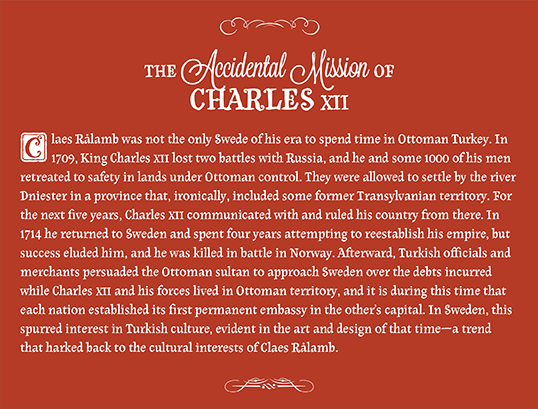 |
 |
Jonathan Stubbs (jon@jstubbs.com) is a freelance writer and editor based in Luleå, Sweden. Born in California, he has lived and worked around the world, and he spent his teen years living in the Middle East. |
| For more information visit www.srii.org |